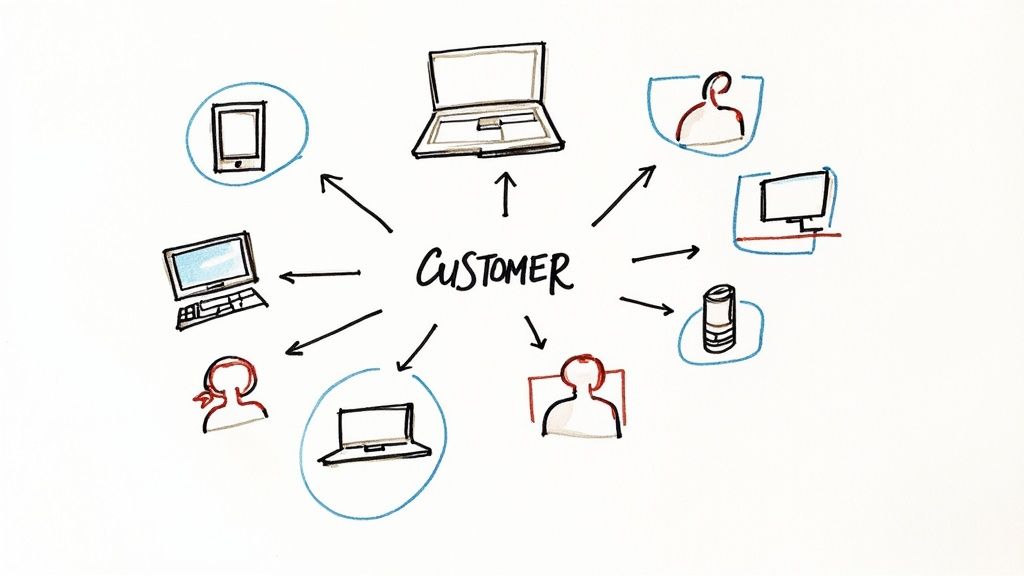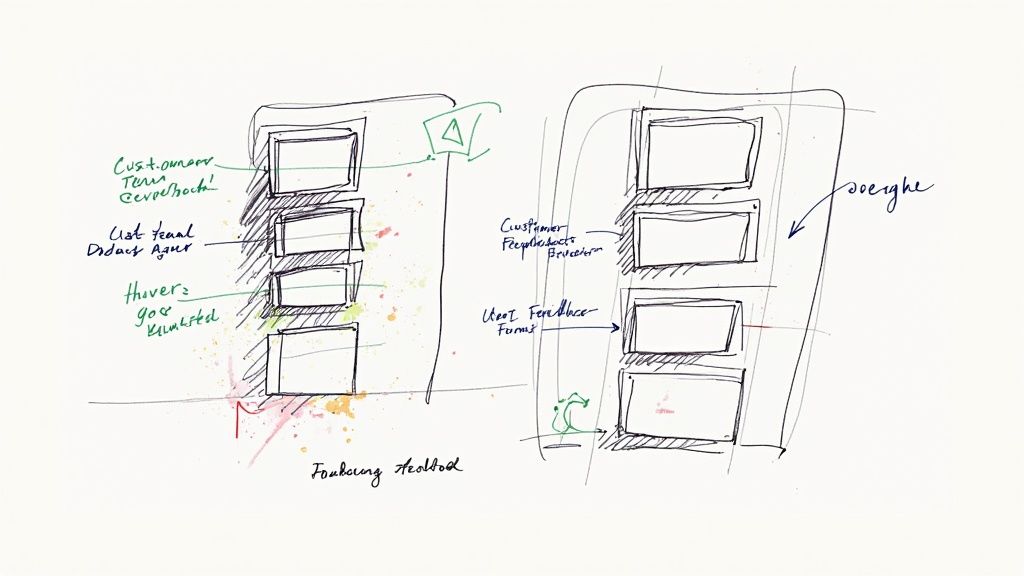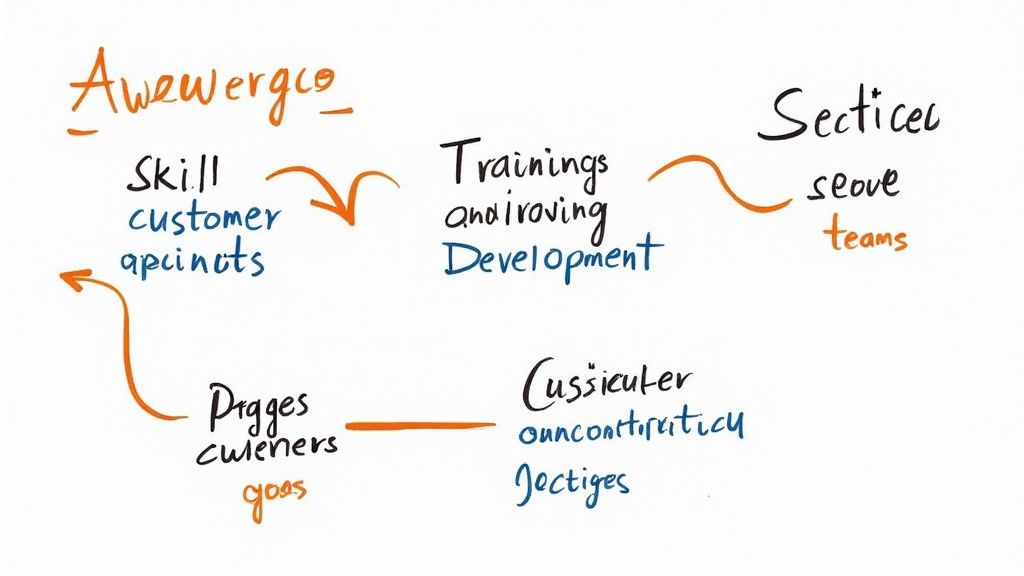10 Proven Customer Service Improvement Strategies That Drive Growth
Strategic Service Metrics That Drive Results

The success of customer service initiatives depends heavily on measuring what truly matters. While many companies still rely on basic metrics like average handle time, these numbers often paint an incomplete picture. A short call duration might seem good on paper, but it could mean representatives are rushing through interactions without properly addressing customer needs. This disconnect between metrics and actual service quality can seriously undermine customer satisfaction.
Better Ways to Measure Success
Smart companies are moving beyond surface-level measurements to track metrics that capture the full customer experience. The Net Promoter Score (NPS) has emerged as a key indicator, measuring how likely customers are to recommend a business to others. The data backs this up - companies that track NPS often grow up to 60% faster than competitors. Even more compelling, about half of businesses using NPS see customer referrals jump by 10% or more. These results show why focusing on loyalty metrics drives real business growth.
Making Customer Feedback Count
Getting meaningful results requires more than just collecting feedback - you need to put that information to work. Consider a restaurant receiving complaints about slow service. Simply logging those complaints doesn't solve anything. But using that feedback to adjust staffing levels or improve kitchen workflows directly addresses the root cause. The key is creating a continuous cycle of gathering input and making concrete improvements based on what customers are saying.
Using Data to Guide Decisions
While collecting customer data is important, the real value comes from analyzing it effectively. Modern analytics tools powered by artificial intelligence help companies process large amounts of feedback to spot trends and improvement opportunities. For instance, sentiment analysis reveals whether customers generally feel positive or negative about their experiences. AI can also identify common themes and pain points mentioned frequently in feedback, giving clear direction on what needs fixing.
Connecting Metrics to Business Success
Your service metrics must support bigger business objectives to drive real results. If customer retention is the goal, then acquisition metrics alone won't cut it - you need to track things like lifetime value and churn rate. When metrics align with business strategy, customer service becomes a core driver of growth rather than just a cost center. This focused approach, combining strategic measurement with systematic feedback and data analysis, helps create lasting service improvements that benefit both customers and the bottom line.
Mastering the Art of Personalized Service

Creating authentic connections with customers requires moving beyond basic service to truly understanding each person's unique needs and preferences. By focusing on personalization as a core strategy, businesses can build lasting relationships that go deeper than simple transactions. Let's explore how to develop and implement personalized service that resonates with customers on an individual level.
Why Personalization Matters
Customers increasingly expect experiences tailored to their specific needs and preferences. Recent studies show that 80% of people are more likely to buy from companies offering personalized experiences. Additionally, 76% report feeling frustrated when businesses fail to customize their interactions. These numbers highlight how personalization directly impacts customer satisfaction and purchasing decisions. When done well, personalized service creates loyal customers who become brand advocates.
Practical Steps to Personalization
Building effective personalization requires a thoughtful, systematic approach. The process begins with smart data collection but must extend to meaningful action.
- Data Collection: Set up systems to track key information like purchase history, browsing patterns, and communication preferences. Make it easy for customers to directly share their interests and needs.
- Segmentation: Create customer groups based on common characteristics to deliver more relevant communications and offers.
- Tailored Interactions: Put customer data to work across all touchpoints - from emails to website visits. Use names in communications, suggest products based on past purchases, and provide support that fits each situation.
For instance, if someone frequently browses hiking gear on an outdoor retailer's site, the company could send them targeted recommendations for boots and backpacks, along with blog posts about local hiking trails. This shows the customer that the business understands and cares about their specific interests.
Balancing Automation and Human Touch
While technology helps scale personalization, the human element remains essential. Finding the right mix of automated and personal interaction creates the best customer experience.
- Automated Personalization: Use automation thoughtfully for tasks like customized email campaigns and product suggestions.
- Human-Driven Interactions: Keep person-to-person contact for complex issues and relationship building. Give service teams the freedom to make decisions based on individual customer needs.
This combined approach maintains efficiency while preserving genuine human connections. Training staff to deliver consistently personalized service is key - they need both the technical tools to access customer data and the soft skills to build relationships effectively. When done right, personalization leads to measurably higher customer satisfaction and long-term value. It's about creating experiences that connect with people as individuals, building lasting loyalty that helps businesses grow naturally.
Building a Seamless Multi-Channel Experience

Connecting with customers across multiple channels is essential for delivering excellent service. Most customers now interact with businesses through various platforms - from emails and phone calls to chat and social media. However, simply being present on multiple channels isn't enough. The key is creating a smooth, integrated experience where customers can seamlessly move between platforms without having to repeat themselves or lose context. When businesses fail to connect these touchpoints effectively, it often leads to frustrated customers and damaged relationships.
Understanding the Omnichannel Approach
True multi-channel success requires thoughtfully connecting all customer interactions into one cohesive experience. Consider a typical customer journey: they might start by checking your website's FAQ section, then hop on live chat with a quick follow-up question, and finally send an email about more complex details. With proper channel integration, service staff can see this full history and context, allowing them to pick up right where the last interaction left off. This saves customers from the headache of explaining their situation multiple times and helps staff provide more helpful, informed responses.
Choosing the Right Channels
Finding the right mix of service channels depends heavily on understanding your specific customers and resources. While traditional channels like phone and email remain important, adding options like live chat or social messaging can make your business more accessible - but only if they match how your customers prefer to communicate. For example, if you serve primarily younger customers, having a mobile-friendly support portal is crucial since 79% of millennials prefer brands that offer this option. However, businesses with older clientele might do better focusing on phone and email support. The goal is selecting channels that work best for both your customers and your team's capabilities.
Resource Allocation and Quality Maintenance
Managing multiple service channels requires careful planning of staff and resources. Each platform needs specific skills and tools - social media demands quick, public responses while email allows for more detailed problem-solving. Start by analyzing which channels get the most traffic and allocate your team accordingly. If live chat sees constant activity, make sure you have enough trained staff to handle conversations promptly. Just as important is maintaining consistent quality across every touchpoint. Regular reviews of response times, customer feedback, and service standards help ensure customers receive the same great experience no matter how they reach out. This attention to quality, combined with smart resource planning, creates a reliable multi-channel system that builds lasting customer relationships.
Harnessing Technology for Service Excellence
When applied thoughtfully, technology can help businesses provide better customer service by complementing and amplifying human capabilities. The goal is to find the sweet spot where automation supports rather than replaces meaningful human connections. This balance is key to improving service quality while maintaining authentic relationships.
Identifying Opportunities for Technology Integration
Before implementing new tools, carefully evaluate which processes would benefit most from automation. Look for tasks that are routine, manual, or error-prone. For instance, basic questions can be handled efficiently by Dialogflow or other AI chatbots, giving your team more time for nuanced customer conversations. Common candidates for automation include scheduling systems, shipment tracking, and standard account updates. This targeted approach creates efficiencies that serve both customers and employees well.
Training Teams to Work Alongside AI
Successful technology adoption requires proper training and change management. Staff need to understand both the technical aspects of new tools and how to collaborate effectively with AI systems. When rolling out an AI-powered Salesforce platform, for example, focus on teaching teams to analyze customer data and use those insights in their interactions. Address concerns about job security openly by showing how AI helps employees work smarter, not replace them. Good training and ongoing support help ensure smooth transitions as teams adapt to new ways of working.
Maintaining the Human Touch in a Digital World
Even as technology becomes more central to customer service, human connection remains essential. People still seek empathy and understanding, particularly for complex issues or sensitive situations. Recent studies show that 42% of consumers use chatbots for quick questions, demonstrating the value of fast, automated responses. However, this automated efficiency works best when paired with personalized human service. Use technology to collect customer data that helps agents provide more relevant and thoughtful support. For example, when staff can easily see a customer's history, they can offer more helpful suggestions and solutions. This combination of efficient systems and genuine human care creates experiences that feel both smooth and personal. The key is using technology in ways that enhance rather than diminish authentic human interactions. Success comes from empowering your team to make judgment calls based on individual situations while having helpful digital tools at their disposal.
Implementing Proactive Service Strategies

Great customer service isn't just about solving problems - it's about preventing them before they happen. This proactive approach makes a real difference: research shows that 95% of businesses see better customer retention when they take initiative to address issues early. Even more telling, 77% of customers say they appreciate companies that fix problems before they have to complain. Let's explore practical ways to build this proactive mindset into your customer service.
Developing Early Warning Systems
To catch issues early, you need reliable ways to spot potential problems. This could mean keeping an eye on social media comments, tracking how often products get returned, or carefully reviewing customer feedback surveys. Some companies use simple spreadsheets to track these signals, while others invest in tools that automatically analyze customer sentiment. The key is having a system - whatever its sophistication level - that helps you identify and address concerns before they grow into bigger problems.
Creating Effective Feedback Loops
Getting feedback is just the first step - what matters is how you use it. When customers tell you something isn't working, take action quickly and let them know what you've done. For instance, if several customers struggle with your website's checkout process, fix it promptly and send them a note about the improvement. This shows you're not just listening, but actively making changes based on their input. Regular cycles of feedback and action build trust and keep customers coming back.
Building Processes That Exceed Expectations
Good service means doing more than fixing problems - it means creating experiences that make customers think "wow." This could be as simple as checking in with new customers after their first purchase or sending personalized product tips based on their interests. Having clear, easy-to-find help resources lets customers solve simple issues on their own, while your team focuses on providing extra value where it matters most. When you consistently go beyond the basics, customers notice and remember.
Implementation Guides for Different Business Sizes
Every business can practice proactive service, regardless of size. A small local shop might start by calling key customers regularly to check in, while larger companies might use advanced analytics to spot trends across thousands of interactions. Whatever your scale, focus on three core actions: spot potential issues early, address them quickly, and find ways to exceed basic expectations. These principles work whether you're serving ten customers or ten thousand.
Real-World Success Stories
The proof is in the results. Take the case of a mid-sized software company that started proactively checking in with customers before renewal dates - their customer lifetime value jumped 40%. Or consider the retail chain that reduced returns by 25% by helping customers pick the right products before purchase. These examples show how taking initiative in customer service creates real business value. When you help customers succeed before they ask, everyone wins.
Developing High-Performance Service Teams
Building an effective customer service strategy starts with one critical element: your people. While tools and processes matter, the team delivering the service makes the real difference. When organizations invest in developing their service teams through training, empowerment, and a positive culture, they create the foundation for consistently excellent customer experiences.
Cultivating Essential Skills for Service Excellence
Success in customer service requires a unique combination of both hard and soft skills. Your team needs more than basic product training - they need abilities that help them connect with and truly serve customers effectively.
- Emotional Intelligence: The ability to understand and manage emotions - both your own and your customers' - is fundamental. When a customer calls about a delayed order, a representative with strong emotional awareness can acknowledge their frustration authentically, apologize sincerely, and work toward a solution that leaves them feeling heard and valued. This skill helps turn difficult situations into opportunities to build trust.
- Problem-Solving Skills: Going beyond standard scripts, effective problem-solving means actively listening, asking smart questions, and finding creative solutions suited to each unique situation. Your team should feel equipped to think independently and take initiative when standard processes don't quite fit.
- Decision-Making Abilities: Teams need clear guidelines and ongoing coaching to make good judgment calls that align with your company's values. When representatives can make decisions independently, it reduces customer wait times and leads to faster issue resolution.
Fostering a Culture of Continuous Improvement
Creating an environment where teams constantly learn and grow is essential for sustained service excellence.
- Regular Feedback and Coaching: Both positive reinforcement and constructive guidance help team members understand their strengths and areas for growth. Individual coaching sessions give representatives the personalized support they need to keep developing their skills.
- Knowledge Sharing and Collaboration: When team members regularly share experiences and best practices, it creates a culture of mutual support and collective growth. This might happen through team meetings, internal forums, or mentoring partnerships between senior and junior staff.
Empowering Teams for Customer-Centric Action
For service teams to truly excel, they need both the tools and the authority to serve customers effectively.
- Access to Information and Resources: Quick access to product details, policies, and customer history allows for faster, more accurate service. When teams can find what they need easily, they can focus fully on helping the customer.
- Decision-Making Authority: Giving teams the power to make decisions within clear boundaries shows trust in their judgment and allows for quick problem resolution. This autonomy helps customers feel valued while boosting team confidence and capability.
When organizations focus on developing these core elements, they build service teams that consistently deliver excellent experiences. This investment in people directly translates to higher customer satisfaction, stronger loyalty, and better business results.
Want to support your service team with smart technology? Sitebot's AI-powered chatbots can handle routine questions, giving your team more time for complex issues and relationship building. Learn more and start your free trial at https://sitebot.co.


